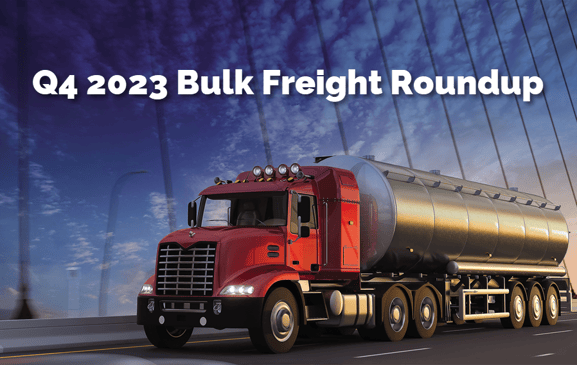We’re reaching the end of Q4 2023 and heading into an exciting new 2024. It hasn’t been a terribly exciting time in the world of bulk trucking for much of 2023 – but that’s not necessarily a bad thing. Given all the unwanted excitement in recent years, a return to normalcy in 2023 has been welcome. In this article, we’ll examine the bulk trucking industry as we currently see it, and look ahead to 2024.
The current state of bulk trucking
 Capacity
Capacity
As it has been for most of the year, capacity is readily available in most lanes in North America. As always, advance booking will improve your chances of moving freight on your precise schedule, but we’re able to accommodate shorter shipping windows than we were in 2022 and 2021.
Trucking operator costs
With capacity easy to come by, you might think that trucking rates would be low. However, as we reported earlier, operating costs within the trucking industry have hit record highs. The American Transportation Research Institute’s (ATRI) 2023 Operational Cost of Trucking report compared 2022 costs to years prior and found that operating costs jumped – from 2021 to 2022 – by 21.3%. These operating costs now add up to $2.251 per mile, which includes:
- Driver wages– Up 15.5% in 2022, accounting for $0.724 per mile
- Truck/trailer lease or purchase payments – Up 18.6% in 2022, accounting for $0.331 per mile
- Repair and maintenance – Up 12% in 2022, accounting for $0.196 per mile
Fuel
Thankfully, this major truck operating cost has started to come back down to earth. After surging in the summer and into the fall, diesel prices have continued to decrease. According to AAA, the national average price for diesel fuel is $4.09 as of mid-December. This is down $0.24 compared to a month ago, and down $0.82 compared to a year ago.
Driver shortage
The trucking industry is still dealing with a driver shortage in which there are more loads than there are drivers to haul them. As such, competition for the services of available drivers remains fierce – and costly.
Within the world of bulk trucking, any easing of the driver shortage is not going to be felt quickly. It’s a longer process to become a bulk truck driver. Drivers don’t simply go to truck driving school and then get behind the wheel of a liquid tanker or dry bulk truck. It often takes years of successful dry van driving before a driver gets an opportunity to ‘move up’ to the bulk world.
Consumer spending
In the world of bulk trucking, consumer spending is the ‘tail that wags the dog.’ If consumer spending picks up, then manufacturing will pick up, and so will bulk transportation. Consumer spending has been strong for much of 2023, which tracks with the relative steadiness of load volumes we’ve seen throughout the year. And, despite inflation and the warnings of economists that consumer spending is going to decline, it still hasn’t.
So, what’s ahead in 2024?
If you have a crystal ball, now would be a good time to use it. Opinions are mixed on what lies ahead in the new year. Some see a continuation of 2023, with steady demand and ample capacity. Others see more turmoil should consumer spending and economic indicators take a downturn.
In the near term, we have the winter to contend with. If it’s a harsh winter in key lanes, that could mean rail disruptions and other challenges that can affect the bulk freight market.
2024 is also an election year which, as we’ve learned, can bring unexpected challenges and opportunities.
Whatever the new year brings, your supply chain will be best served if you stay close to your trusted transportation partners and let them guide you through changing market conditions. This means taking advantage of opportunities that arise and addressing challenges that threaten your operations.
At Bulk Connection, we pride ourselves on being a trusted bulk freight 3PL partner to many name-brand companies within the chemical, industrial and food industries. Contact us today to learn how we can support your supply chain in the year ahead.




